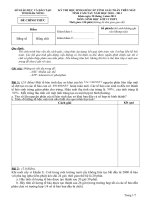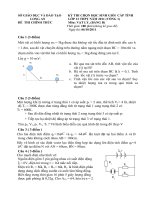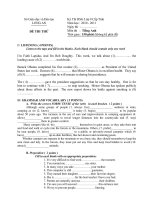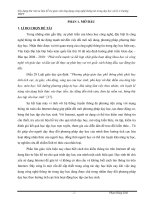tranh sinh hoc 7 sinh học 7 đỗ phương thảo thư viện tư liệu giáo dục
Bạn đang xem bản rút gọn của tài liệu. Xem và tải ngay bản đầy đủ của tài liệu tại đây (41.92 KB, 28 trang )
<span class='text_page_counter'>(1)</span><div class='page_container' data-page=1>
<b>Lecture 5</b>
<b>Stress</b>
• <b>Definition</b>
• <b>Types of stress</b>
• <b>Nature of stress</b>
• <b>Placement of stress within words</b>
• <b>Simple words</b>
• <b>Derived words</b>
• <b>Compound words</b>
</div>
<span class='text_page_counter'>(2)</span><div class='page_container' data-page=2>
<b>Definition</b>
• Stress is an extra force exerted on a particular syllable
or a particular word in spoken language. The stressed
syllable or word is said with greater energy, and stands
out in a word, phrase or sentence. Examples:
</div>
<span class='text_page_counter'>(3)</span><div class='page_container' data-page=3>
<b>Types of stress</b>
<b>1.</b> <b>Word stress</b>: is an extra force put on a particular
syllable of the word. It is usually fixed. For example:
invite entertain
<b>2.</b> <b>Sentence stress</b>: is an extra force put on a particular
word in a sentence. Sentence stress is not fixed. It
depends on the speaker’s feelings and attitudes and
the message that he wants to get across to the
</div>
<span class='text_page_counter'>(4)</span><div class='page_container' data-page=4>
<b>The nature of stress</b>
• We can study stress from the point of view of production
and perception.
1. From the production point of view, the production of
stress is generally believed to depend on the speaker’s
using more muscular energy than for unstressed
syllables.
2. From the perception point of view: all stressed syllables
have one characteristic in common, and that is
</div>
<span class='text_page_counter'>(5)</span><div class='page_container' data-page=5>
<b>Levels of stress</b>
<b>1.</b> <b>Primary stress (tonic/nuclear):</b> is the strongest type of
stress. It is marked by a small vertical line high up just
before the syllable it relates to.
<b>2.</b> <b>Secondary stress (non-tonic):</b> it is weaker than
primary stress, but stronger than unstressed syllables. It
is usually found in words of four or five syllables. It is
represented in transcription with a low mark. For
examples:
photographic economical
anthropology nationality
</div>
<span class='text_page_counter'>(6)</span><div class='page_container' data-page=6>
<b>Placement of stress within words</b>
• In order to decide on the stress placement, it is
necessary to make use of some or all of the following
information.
a. Whether the word is morphologically simple or
complex.
(whether the word is a simple, derived or compound
word).
a. The grammatical category to which the word belongs.
b. The number of syllables in the word.
</div>
<span class='text_page_counter'>(7)</span><div class='page_container' data-page=7>
<b>Simple word stress</b>
<b>1.</b> <b>Two syllable words</b>
a. Verbs
b. Adjectives
c. Nouns
d. Adverbs and prepositions
2. <b>Three syllable words</b>
a. Verbs
b. Nouns
</div>
<span class='text_page_counter'>(8)</span><div class='page_container' data-page=8>
<b>Two-syllable verbs</b>
a. If the second syllable of the verb contains a long
vowel or a diphthong or it ends with more than
one consonant, that second syllable is stressed.
E.g.
<i>provide</i>
<i>protest</i>
<i>contain</i>
<i>agree</i>
</div>
<span class='text_page_counter'>(9)</span><div class='page_container' data-page=9>
b. If the second syllable contains a short vowel and
ends with one or no consonant, the first syllable is
stressed. Examples:
<i>enter</i>
<i>worry</i>
<i>travel</i>
<i>open</i>
•
More examples:
<i>menace, settle, marry, differ, </i>
<i>equal, answer.</i>
c. The final syllable is also unstressed if it contains
/
@U
/. Examples:
</div>
<span class='text_page_counter'>(10)</span><div class='page_container' data-page=10>
<b>Two-syllable Adjectives</b>
• Two syllable adjectives are stressed according to
the same rules as verbs. Examples:
<i>correct</i>
<i>major</i>
<i>polite</i>
<i>complete</i>
<i>heavy</i>
<i>happy</i>
</div>
<span class='text_page_counter'>(11)</span><div class='page_container' data-page=11>
<b>Two-syllable Nouns</b>
a. If the second syllable contains a short vowel, the
stress will be on the first syllable. Otherwise, it will
be on the second syllable.
<i>money</i>
<i>reason</i>
<i>office</i>
<i>larynx</i>
<i>estate</i>
<i>balloon</i>
<i>autumn</i>
<i>affair</i>
<i>delight</i>
<i>pocket</i>
</div>
<span class='text_page_counter'>(12)</span><div class='page_container' data-page=12>
<b>Notes</b>
• Other two-syllable words such as adverbs and
prepositions seem to behave like verbs and
adjectives. Examples:
<i>beyond</i>
<i>never</i>
<i>seldom</i>
<i>behind</i>
<i>again</i>
<i>very</i>
<i>before</i>
<i>after</i>
</div>
<span class='text_page_counter'>(13)</span><div class='page_container' data-page=13>
<b>Three-syllable verbs</b>
a. If the last syllable contains a short vowel and ends
with not more than one consonant, the last syllable
will be unstressed, and stress will be placed on the
second syllable.
<i>encounter</i> <i>determine</i>
<i>abandon</i> <i>remember</i>
b. If the final syllable contains a long vowel or a
diphthong, or ends with more than one consonant,
the final syllable will be stressed.
</div>
<span class='text_page_counter'>(14)</span><div class='page_container' data-page=14>
<b>Three-syllable Nouns</b>
a. If the final syllalbe contains a short vowel or /@U/, it is
unstressed. If the second syllable contains a long
vowel or a diphthong, or it ends with more than one
consonant, the second syllable will be stressed.
<i>potato</i> <i>disaster</i>
<i>cathedral</i> <i>advantage</i>
b. If the final syllable contains a short vowel and the
second syllable contains a short vowel and ends with
not more than one consonant, both the final and
</div>
<span class='text_page_counter'>(15)</span><div class='page_container' data-page=15>
<i>quantity</i> <i>cinema</i>
<i>enemy</i> <i>alphabet</i>
<i>animal</i> <i>company</i>
<i>antonym</i> <i>character</i>
c. If the final syllalbe contains a long vowel or a
diphthong or it ends with more than one consonant,
the stress will usually be placed on the first syllable.
<i>paradise</i> <i>exercise</i>
<i>architect</i> <i>marigold</i>
</div>
<span class='text_page_counter'>(16)</span><div class='page_container' data-page=16>
<b>Three-syllable Adjectives</b>
• Three-syllable adjectives seem to need the same
rules as Nouns to produce stress pattern such as:
<i>opportune</i>
<i>insolent</i>
<i>possible</i>
<i>derelict</i>
<i>important</i>
<i>absolute</i>
<i>enormous</i>
<i>similar</i>
</div>
<span class='text_page_counter'>(17)</span><div class='page_container' data-page=17>
<b>Complex word stress</b>
• Derived words
• Stress on the affix
• No change in stress placement
• The stress remains on the stem but is shifted to
a different syllable.
• Compound words
</div>
<span class='text_page_counter'>(18)</span><div class='page_container' data-page=18>
<b>Stress in derived words</b>
• The affixes will have one of three possible effects on
the word stress.
1. The affix itself receives primary stress.
<i>circle</i> <i>semi-circle</i>
<i>employ</i> <i>employee</i>
<i>person</i> <i>personality</i>
<i>Portugal</i> <i>Portugese</i>
<i>cigar</i> <i>cigarette</i>
<i>picture</i> <i>picturesque</i>
</div>
<span class='text_page_counter'>(19)</span><div class='page_container' data-page=19>
2. The word is stressed as if the affix were not there.
<i>comfort</i> <i>comfortable</i>
<i>marry</i> <i>marriage</i>
<i>refuse</i> <i>refusal</i>
<i>wide</i> <i>widen</i>
<i>wonder</i> <i>wonderful</i>
<i>amaze</i> <i>amazing</i>
<i>red</i> <i>reddish</i>
<i>power</i> <i>powerless</i>
<i>punish</i> <i>punishment</i>
<i>poison</i> <i>poisonous</i>
</div>
<span class='text_page_counter'>(20)</span><div class='page_container' data-page=20>
3. The stress remains on the stem, not the affix, but
is shifted to a different syllable.
<i>advantage</i>
<i>advantageous</i>
<i>proverb</i>
<i>proverbial</i>
<i>climate</i>
<i>climatic</i>
<i>injure</i>
<i>injurious</i>
<i>tranquil</i>
<i>tranquility</i>
<i>photograph</i>
<i>photographer</i>
<i>economy</i>
<i>economical</i>
</div>
<span class='text_page_counter'>(21)</span><div class='page_container' data-page=21>
<b>Compound words</b>
a. If the first word/part of the compound is in a broad
sense adjectival, the stress goes on the second
element with a secondary stress on the first.
<i>loudspeaker</i>
<i>full moon</i>
</div>
<span class='text_page_counter'>(22)</span><div class='page_container' data-page=22>
b. If, however, the first element is, in a broad sense, a
noun, the stress goes on the first element.
<i>car ferry</i>
<i>tea cup</i>
<i>suitcase</i>
<i>bottle feed</i>
<i>boatpeople</i>
<i>farm house</i>
<i>airplane</i>
</div>
<span class='text_page_counter'>(23)</span><div class='page_container' data-page=23>
<b>Word class pairs</b>
• In English, there are pairs of two syllable words with
identical spelling which differ from each other in stress
placement, apparently according to word class. The
rule is as follows: The stress will be placed on the
second syllable if the word is a Verb, but on the first
syllable of the Noun or Adjective.
<i>abstract abstract</i>
<i>conduct</i> <i>conduct</i>
<i>contrast</i> <i>contrast</i>
</div>
<span class='text_page_counter'>(24)</span><div class='page_container' data-page=24>
24
<i>escort</i> <i>escort</i>
<i>export</i> <i>export</i>
<i>import</i> <i>import</i>
<i>insult</i> <i>insult</i>
<i>object</i> <i>object</i>
<i>perfect</i> <i>perfect</i>
<i>permit</i> <i>permit</i>
<i>present</i> <i>present</i>
<i>produce</i> <i>produce</i>
<i>rebel</i> <i>rebel</i>
<i>record</i> <i>record</i>
</div>
<span class='text_page_counter'>(25)</span><div class='page_container' data-page=25>
<b>Strong and weak forms</b>
• There are certain well-known English words that can be
pronounced in two different ways which are called strong
form and weak form.
I like <i>that</i>
I hope <i>that</i> you are fine
• It is possible to use only strong forms in speaking, and
some foreigners do this. Usually, they can still be
understood by other speakers of English, so why is it
important to learn how weak forms are used?
a. Most native speakers of English find an ‘all-strong-form’
</div>
<span class='text_page_counter'>(26)</span><div class='page_container' data-page=26>
• More importantly, speakers who are not familiar with the
use of weak forms are likely to have difficulty
understanding speakers who do use weak forms. Since
practically all native speakers of English use them,
learners of the language need to learn about these weak
forms to help them understand what they hear.
• Almost all the words which have both a strong and weak
form belong to a category that may be called grammatical
words such as auxiliary verbs, prepositions,
conjunctions... It is important to remember that there are
certain contexts in which only the strong form is
</div>
<span class='text_page_counter'>(27)</span><div class='page_container' data-page=27>
• The strong form is used in the following cases:
a. When the word occurs at the end of a sentence.
What are you looking at?
I am looking at my pictures.
Where are you from?
I am from Vietnam
b. When a weak form word is being contrasted with
another word.
</div>
<span class='text_page_counter'>(28)</span><div class='page_container' data-page=28>
• A similar case is what we might call a co-ordinated
use of prepositions.
I travel to and from London a lot.
A work of and about literature.
c. When a weak form word is given stress for the
purpose of emphasis.
You must marry me
I have to go
You must choose us or them.
</div>
<!--links-->









